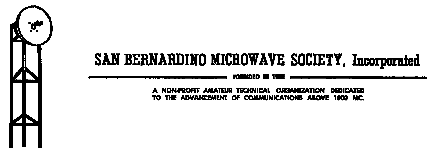

August 2004 Edition
President Chris Shoaff N9RIN 2911 Calle Heraldo San Clemente CA 92673 949-388-3121 cshoaff@netzero.net
Vice President Larry Johnston, K6HLH 16611 E Valeport Ave Lancaster, CA 93535 661-264-3126 ljohns@qnet.com
Recording Sec Mel Swanberg, WA6JBD 231 E Alessandro Blvd Riverside, CA 92508 909-369-6515 wa6jbd@verizon.net
Corresponding Sec Kurt Geitner, K6RRA1077 E Pacific Coast Hwy TMB142 Seal Beach, CA 90740 310-718-4910 k6rra@gte.net
Treasurer Dick Kolbly, K6HIJ 26335 Community Barstow, CA 92311 760-253-2477 dick@eventhorizons.com
Editor Bill Burns, WA6QYR 247 Rebel Rd Ridgecrest, CA 93555 760-375-8566 bburns@ridgecrest.ca.us
Webmaster Chip Angle, N6CA 25309 Andreo Lomita, CA 90717 310-539-5395 chip@anglelinear.com
ARRL Interface Frank Kelly, WB6CWN 1111 Rancho Conejo Blvd. #501 Newbury Park, CA 91320
805-499-8047 wb6cwn@version.net
W6IFE License Trustee Ed Munn, W6OYJ 6255 Radcliffe Dr. San Diego, CA 92122 858-453-4563
w6oyj@amsat.org.
At the 5 August SBMS Meeting we will be Planning for the up coming contest.. The SBMS meets at the American Legion Hall 1024 Main Street (south of the 91 freeway) in Corona, CA at 1900 hours local time on the first Thursday of each month. Check out the SBMS web site at http://www.ham-radio.com/sbms/.
SBMS meeting parking- We have become a great number of members at meetings. We park next to the church in the adjacent lot or on the street and or in the lot across the street. Across the street the sign on the building shows: 1025 Main Street. MAIN STREET BISTRO. The sign on the parking lot says: CLIN CHIROPRACTIC CARE Dick, WB6DNX
A reminder that the third Saturday of each month is Microwave Activity Day starting after the Pomona/ Cal Poly Swap meet through mid afternoon.
Last meeting_ Chip, N6CA had a computer power point presentation about the basic transverter with reference to the 10GHz versions he is building for Paul, KH6HME in Hawaii. Mel, WA6JBD had his 3 versions of transverter to show. Mel discussed use of the microwave "brick" approach he used in his first version followed by the NEC synthesizer and step recovery diode approach he used. Mel's main idea was being modular with reliability in back up parts and good construction of wire Wayne, KH6WZ demonstrated his latest 10 GHz rig with FT-817 if radio. Wayne's approach was to be modular and Velcro doesn't keep things from moving around cabling. Christopher Best, KB3DXR of Huntsville, AL was our visitor. Welcome. Doug, K6JEY talked about progress being made o the Owens Valley Radio Observatory Project with the addition of schools being able to do experiments with pulses sent from the main site. 26 People present
Scheduling.
7-8 August ARRL UHF Contest
21-22 August ARRL 10 GHz and Up Contest
11-12 September ARRL September VHF QSO Party
18-19 September ARRL 10 GHz and Up Contest
14-16 October 2004 Microwave Update in Texas
"Wants and Gots for sale"
Want 2C39/ 7289 tubes GE or Muehutt Doug Millar
Want 10 MHz Crystal filters Mike WB6DJI
Want six 100 ft runs of used 7/8th inch hardline and connectors Mike W6YLZ 19756 Malden St. Winnetka, CA 818-349-8525 H, 310-423-3567W, 310-383-1000 Cell.
Want 10 GHz un-built DB6NT transverter with all parts David KI6FF 714-891-5752
Want 3456 MHz mixer Ken W6DTA 818-848-9059
For Sale US Tower MA550 Tower 50 ft tubular $450 Larry, K6HLH 661-264-3126
below: Larry, K6HLH had an indicator for checking to see that his microwave transmitter was really transmitting. He made it from an old meter from some instrument that had been scraped and added a waveguide transition with detector to supply a current indication on the meter when it was in front of a working transmitter. It would most likely work on several bands around the WR-90 waveguide frequency.
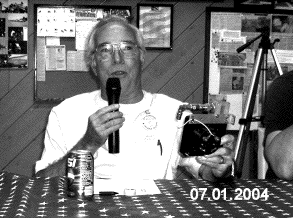
Activity reported at the July SBMS meeting were: Chris, N9RIN is reworking his 10 GHz rig; Mel, WA6JBD is working on his 3rd version of 10 GHz transverter; Chuck, WA6EXV worked WB6CWN in San Diego from Ridgecrest with a broken waveguide feed on 10 GHz (see SBMS web page pix) and is working on his controller; Bill, WA6QYR has been working on a Mojave TVI problem; Ken, W6DTA worked the VHF contest from DM22 on 900, 1200MHz and 10 GHz; Mike, W6YLZ is working to get his rig weight down under 55 pounds and has a small 24 v supply to help with the TWT requirements; Doug, K6JEY was on vacation to Alaska and had a small keyer and oscillator to show; Dennis, WA6NIA worked the contest and Field Day on 10 GHz; Pat, N6RMJ found a "new spot" in the Mojave (the old 10 GHz Gunnplexers site of EXV and QYR) to work the contest and Field Day, and is now on 3456 MHz; Jeff, KN6VR has a working tower now; Mike, W6YLZ cleaned his shop; Bob, WA6VHS has a working 10 GHz rig and is working on the Verticon synthesizer; John, KJ6HZ worked the contest on 6 bands; Kurt, K6RRA worked the contest; Wayne, KH6WZ worked the contest and Field day on 10 GHz; visitor Chris, KB3DXR is working on getting his system up; Larry KG6EG worked the contest; Chip, N6CA got ready for his tech talk; Dick, K6HIJ did some work on the Owens Valley antenna design; Larry, K6HLH worked 7 bands during the contest and had a power detector to show; Gary, W6JKVC had some military interference on 433-435 MHz; and Glenn, KE6HPZ worked the contest on 11 bands.
2005 Microwave Update Planning
On the Microwave Update 2005 Pat N6RMJ is the leader and Dick, K6HIJ is the registration person. Initially they are looking at the Sheridan in Cerritos, CA for the site. Chip, N6CA is setting up the speaker list and encouraging everyone to use a power point type presentation for his or her material. Chip will also take care of the proceedings being published. The operation needs a list of surplus electronic hardware places to visit on Thursday tour. The list needs to include where the store is located and hours of operation and what types of materials are available. Bill, WA6QYR is collecting the list of stores. Judy, KC6UTF has volunteered to help with the XYL/ Spouse tours. This will be also the 50th anniversary of the SBMS so we are looking for materials on the first few years of operation to present. The Dates will be 27-28-29 October 2005.
Where is the info on your favorite surplus or shopping spot for electronic goodies? Forward that to bburns@ridgenet.net yet.
New inputs on stores to visit during MUD 2005-
OK, I figured that everyone knew about these places, but I have not seen anyone post anything on the reflector. Where does everyone go for "stuff"? I would like to know where people go for microwave and RF surplus, since I seem to have places for non-RF stuff.
Here is a place someone told me about this morning, it's an online store:
Electronic Inventory Online---Lots of misc. electrical and electronic items- http://www.ejo.com/
Here is my list, for Orange County. I already mentioned JK Electronics and Earl's Industrial.
ORVAC Electronics 1645 E. Orange Thorpe Ave Fullerton, CA 92381 Phone - 714-871-1020 M-F - 8:30 to 6 SAT - 9 to 5:30
SAV-ON Electronics 13225 Harbor Blvd Garden Grove, CA 92843 Phone - 714-530-0555 M-SAT - 9:30 to 6
Ford Electronics 8431 Commonwealth Ave Buena Park, CA 90621 Phone - 714-521-8080 M-F - 9 to 6 SAT 9 to 5 http:// www.fordelectronics.com
Ball Electronics 2960 W Ball Road Anaheim, CA 92804 Phone - 714-828-1310 M-F - 8 to 5 SAT - 10 to 5 SUN - 10 to 3
NOTE: I have not gone to most of these places since the mid-80's when I was in high school, but they are still around. All these places have new and surplus electronic items, but not much RF- or microwave-specific things. However, these places are all excellent alternatives to Fry's or Radio Shack . . .. Wayne, KH6WZ
Every ham should visit Apex Electronics at San Fernando and Tuxford Rd in Sun Valley. You can build or repair anything from their huge electronic surplus inventory. They have RF and waveguide parts. Just a mile to the south in Burbank is Industrial Metal Supply. They sell common metals in most shapes for industrial/commercial use, but also over the counter to you and me. Sheet, extrusion, bar, tube, rods, etc. They will cut for a small fee. Frank WB6CWN
below: Mel, WA6JBD discussed his various version of 10 GHz transverter at the July SBMS meeting. On the left is his first rig that has continued to have modifications made to it so that it was becoming more reliable and had modules that could be cabled around if there had been a failure in a section. On the right is the third version, which is coming along nicely. It has some of the modifications of the first versions in addition to later thoughts and changes to make a rig that is still better yet.
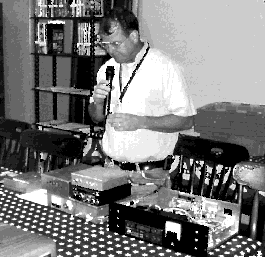
Owens Valley Radio Observatory Project.
Doug, K6JEY is the lead contact on the project. Dennis, WA6NIA is the schedule keeper. Dick, K6HIJ is doing the design on the antenna package. Chuck, WA6EXV is in charge of the hardware construction for the radios in the feed structure as well as the structure. The written project description has been approved by the site manager and is in the hands of the Cal Tech managers awaiting approval. The initial plan is to provide 1296 MHz and 10 GHz transverter for the feed of the 120 ft dish at Big Pine site for education to schools around the world.
below:Wayne, KH6WZ shows his 10 GHz rig to members at the July SBMS meeting. His package has a photo shoe to attach it to the tripod and used a metal box he happened to have that was big enough to hold all the pieces. The wooden handles on the sides helped control the pointing when in the field. The dish antenna slips over the feed when all is on the tripod. His power amplifier is mounted on the upper edge of the arrangement to keep the heat from the rest of the rig. Wayne uses power poles for interconnection to batteries under the tripod. His FT-817 IF radio fits in the middle of the assembly along with a DSP audio unit to help with the received signal bandwidths. Modular construction was one of Wayne's points in discussing the pluses of his set up.
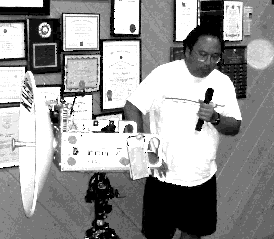
Simple Rectangular to Circular Microwave Waveguide Transitions
D. A. Bathker K6BLG
Summer 2004
For Richard Kolbly K6HIJ and possibly the SB Microwave Society
It often becomes necessary to connect dominant mode rectangular cross-section waveguide (wg) to dominant mode circular wg with low reflection (and wg mode purity). The most common example is to connect a TE-10 rectangular wg to a TE-11 circular wg to be used for a feed on a microwave dish. In this case the wg modes have similar field patterns and a simple solution arises.
A difficult way to do this is to construct a taper of some sort, usually over a length of a few or several wavelengths, gently blending the two cross-sections. If either wg is operating near cutoff, or even towards the low end of the recommended rectangular wg band, reflections will be large and highly variable with frequency. This occurs because the taper is being forced to convert the 'input' guide wavelength (gw) to the 'output' gw (in addition to converting the impedances and slight field pattern changes). The two gw may differ greatly and give rise, in the main, to the reflections. Such gw-changing transitions are called inhomogeneous transitions.
A simple alternative is to first size one (or the other) TE waveguide to force the guide wavelengths to be equal, throughout. In the case at hand, generally, the rectangular wg is fixed by standards (e.g. WR-42, perhaps a preamp input), leaving the circular wg diameter for the feed as a variable. When the gw is uniform throughout, the (mini) wg system is called homogeneous.
Then, a simple, single-section, quarter wave (gw) impedance-and-mode-changing transition (transformer) is all that is needed for many applications. For very broadband applications as many as 4-quarter wave sections have been used, with full rectangular wg bandwidth being accommodated with low reflection (Ref.1). The modest bandwidth solution is only a quarter wave in length while the broadband solution is but one wavelength in length, far better than a typical taper and usually better performing as well.
Let us design a simple single-section quarter wave transformer, to connect WR-42 to a TE-11 mode wg feed. We adopt 24.192 GHz as the center frequency
The first principle is to size the circular wg to match the rectangular wg gw. This means the cutoff wavelengths must be equal. Once that is done, the TE gw's will track (be equal) with frequency, any frequency.
The second principle comes to us from old coaxial practice (coaxial being a homogeneous "wg" given a uniform dielectric constant throughout). The second principle is the familiar quarter wave impedance matching section Z' = sqrt (Zin x Zout). This works for coaxial as we all know, and it works for homogeneous hollow wg's as well.
Lambda-c (cutoff wl) for TE-10 rectangular 'guide is (lambda-c = 2a) with (a) being the width of the 'guide. Lambda-c for circular 'guide (TE-11 mode) is (lambda-c = 2 Pi r/1.84118...) where Pi is 3.14159..., r is the radius of the circular 'guide and the 1.84118... well, that's a Bessel Function root; it's just wrapped up in the physics of the matter and we won't be intimidated by that.
We next set the two cutoff equations to be equal; 2a = 2Pi r/1.84118. In other words, for any "a" (rectangular wg width), there is a corresponding "r" (circular, TE11 mode wg radius) that forces the 'guide cutoff wl equality and hence the 'guide wl tracking &endash; the homogeneous solution. In the case of WR-42 (a = 0.420 inches) the corresponding circular 'guide radius is 0.246 inches. (Do the arithmetic). This ensures the wanted behavior and note, the size of the required circular guide is a bit larger than you may be used to; here, for WR-42 we must use 0.492 inch diameter.
All we have to do then is to design the intermediate matching section. Now, the equation for TE-mode impedance* (either rectangular or circular cross-section) is given by Zo = 2b/a, where b is the height and a is the width of the rectangular 'guide and b = a = 2r for the circular TE-11 'guide (!). In other words, for WR-42 (b = 0.420 inches, a = 0.210 inches) Zo = 1.000 (relative) (at any frequency) and for a circular 'guide of radius 0.246 inches Zo = 2.000 (relative) (at any frequency). This is true for any frequency in either 'guide.
This is the "secret" of the whole matter of connecting these two 'guides ... the impedance ratio is always two (2), whenever their cutoff wl (and therefore their tracking 'guide wavelengths) are equal.
Then by our old coaxial knowledge, the single quarter wave transformer necessary to connect these two 'guides should have an impedance of [(sq-rt) ( Zin*Zout)] = 1.414Zo. (sq-rt 2Zo). Knowing that Zo = 2b/a, for all 3 of these TE 'guides, we can confidently say 2b/a = 1.414, or b/a = 0.7071, then b (the quarter wave section) = sq rt (0.210 x 0.492) = 0.321 inches and a = b/0.7071 = 0.455 inches. (Do the arithmetic).
So, to connect the rectangular WR-42 to a circular TE-11 'guide (of diameter 0.492 inches) one needs a 'simple' short quarter wave (gw) section of specially machined 'guide, having the dimensions of a = 0.455 inches by b = 0.321 inches, the corners of which are to be truncated by the 0.492 inch diameter. Thus, the matching transformer cross-section is a hybrid of rectangular and circular 'guides but with specific impedance level (1.414 relative).
The length of the matching transformer must be a quarter wave long in guide wl at the frequency needed. For 24.192 GHz the TE 'guide wl (for any and all of the three wg's) is very close to 0.600 inch. A quarter guide wl is therefore 0.150 inch. Because E-plane steps dominate in this design (respectively 0.055 and 0.086 inches, one-sided) with the H-plane steps being so small (each is only 0.018 inch, one-sided) and because E-plane steps introduce a shunt capacitance (just as in coaxial lines) the final transformer length needs to be about 95% of the true quarter wave gw, or 0.142 inches.
To preserve mode purity (the TE-11 "output") it is recommended such "simple" transitions be highly mechanically symmetric (up-down, and sideways) to a few thousandths of an inch, to prevent higher-order waveguide modes to be excited, particularly near the higher end of the (rectangular standard recommended) wg band. Likewise, the feed itself, with slightly large input diameter needs to be sensibly symmetric as well.
Note: I have built and used several of such transformers in the 900 and 1200 MHz and 3.7-4.2, 7-8 and 11.7-12.2 GHz bands with good results. No more long, disappointing tapers for me. You too, I suggest.
I have tried to clarify this description of a simple-minded process, which has been found to be not so simple to describe after all. Anyone with questions, criticisms or comments should contact the author &endash; K6BLG, Box 23 La Canada, CA, 91012. Good microwaving Gents.....
Dan A. Bathker K6BLG JPL (Ret.) *Power-Voltage definition to be exact, but it doesn't matter if we are consistent (and we are).
Ref: IEEE Trans. MTT, Feb. 1967 pp. 128-130
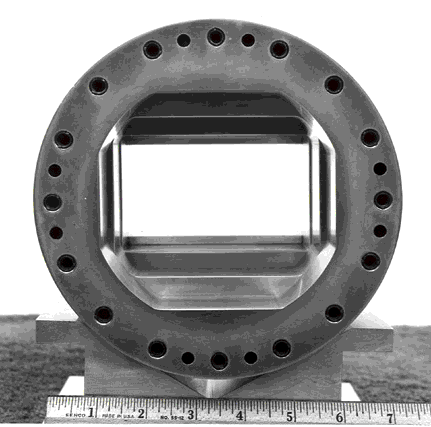
4-Section Homogeneous Transformer WR-430 to WC-504
(2.150 x 4.300 to 5.040 inch diam) 1.7-2.6 GHz VSWR Max = 1.05
(To illustrate a, b, and the corner radii)
below: Chip, N6CA presented a power point presentation on the lay out of the typical microwave transverter along with pictures of what he was assembling for both himself and Paul, KH6HME in Hawaii. The plan was to have a good low noise rig with several watts of transmit power to over come the distance between Hawaii and the mainland during the "Hawaii season" starting in July through the month of August. The Produland 4 foot off set feed dish was already in place atop the volcano in Hawaii. The feed is to be a W2IMU type design.
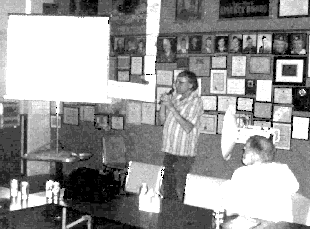
73's Bill